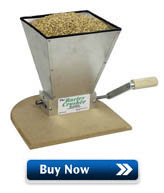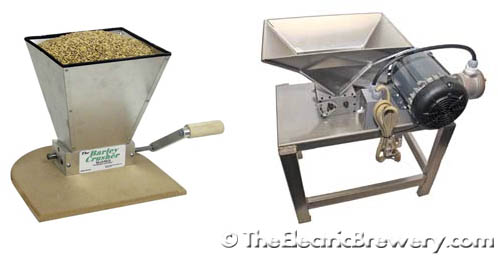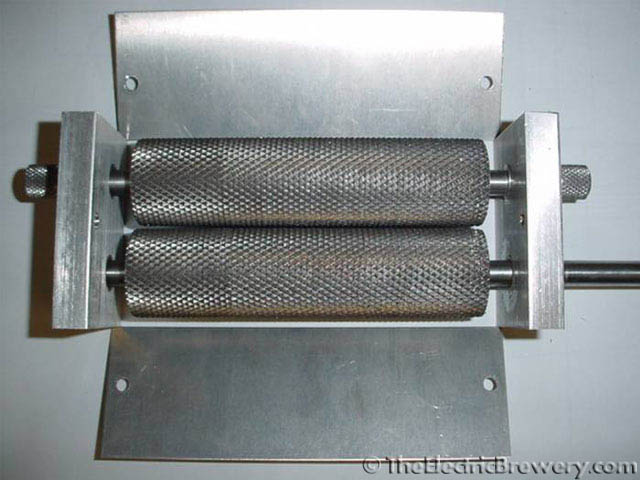Grain Mill
 Before the malted grains (often simply called 'malt') can be mashed in the Mash/Lauter Tun, they need to be crushed or 'milled' in order to expose the starches inside. This makes it easier for the water to extract sugars and other desirables.
Before the malted grains (often simply called 'malt') can be mashed in the Mash/Lauter Tun, they need to be crushed or 'milled' in order to expose the starches inside. This makes it easier for the water to extract sugars and other desirables.
When milling we want to break the kernel into multiple smaller prices but leave the husk as intact as possible as it creates a natural filter in the Mash/Lauter Tun allowing the water to pass through when pumped. Some mills have an adjustable gap size which allows the amount of crushing to be adjusted. A smaller gap size results in a finer crush while a larger gap size results in a coarser crush.
On systems where the wort is not recirculated, the finer the crush the easier it is for the sugars to be extracted which results in a higher efficiency which in turn means that less grain is needed. Too fine of a crush however can result in grain that has been basically turned into flour which can cause what's called a 'stuck mash'. A stuck mash is a sticky mess that water cannot flow through causing clogging. With a recirculating system such as ours, a coarser crush is recommended. A fine crush is not required and may actually be detrimental to sugar extraction process as it impedes fluid flow. Too fine of a crush can also overly shred the grain husks, which can result in extracting too many husk tannins causing an overly astringent (mouth puckering) taste in the beer if the conditions are right.
A grain mill is actually an optional piece of equipment as most stores that sell grain will also mill it for you at the time of purchase for a (usually) small nominal fee or for free. Brewers like us who use an all-grain brewing setup and tend to brew at least once a month should consider purchasing their own mills for the following reasons:
- Cost savings: Grain costs considerably less when purchased in bulk in 50-55 pound sacks (often less than half the price). This grain is unmilled. We typically purchase a year's worth of grain at a time and store them in plastic buckets sealed airtight with easy to open Gamma Seal lids.
- Increased freshness: Un-milled grain stays fresh longer. (Especially important when buying grain in bulk).
- Consistency and control: Different stores use different mills set to varying gap sizes. Stores may adjust or change their mill without your knowledge. This will produce inconsistent results, usually in the form of higher or lower alcohol content than expected, which in turn affects the flavour. We like to be 100% in control of our beer so we use our own mill.
By purchasing 50-55 lb sacks of un-milled grain we save 50% or more as compared to buying by the pound.

Grain before milling:
After milling:
What kinds of mills can be used for brewing?
Brewers only accentuating small batches of beer brewed on the stove with liquid or dry malt extract (concentrated wort) can get away with using a rolling pin to crush the grain as the amount used (when any is used at all) is only a few handfuls.
Beer on our Electric Brewery setup is brewed with 100% grain (no extract) which means that considerably more grain must be used. On our setup, a typical 10 gallon batch of beer will require anywhere from around 10 lbs of grain for a 3% ABV (alcohol by volume) Lite American Lager to almost 40 lbs for a strong 12% ABV Barleywine.
Trying to crush that much grain with a rolling pin is just not feasible (not to mention messy and inconsistent).
Crushing a small amount of grain with a rolling pin:
The next step up is a hand cranked Corona style mill sold under various names like Victoria or Porkert. These mills resemble a sausage grinder.
Corona style mills crush the grain by forcing it through two rotating plates. Some are not adjustable, which tends to overly shred the husk and crush the grain into a powder. The funnel that holds the grain (called a 'hopper') is small and only holds 1-2 pounds of grain at a time.
The main advantage of a Corona style mill is the low price: Some lesser known brands can be had for only $20-30 USD while the Victoria or Porkert can be had for $40-60.
These mills are a good choice for the budget conscious extract brewer who wants to accentuate their beer with a small amount of grain. They are not recommended for all-grain brewers using our Electric Brewery setup.
All-grain brewers will instead use what's referred to as a roller mill. Most are available in single or dual roller configuration. Single roller mills crush the grain between a moving roller and a stationary roller. Single roller mills are hard to find on the market today as dual roller mills offer substantial advantages for very little incremental cost. On a dual roller mill both rollers spin and provide the best overall crush while leaving the husks largely intact.
Most dual roller mills are adjustable, allowing the brewer to increase or decrease the size of the gap to adjust the crush. These mills can be cranked by hand or turned with a hand drill or even a dedicated mounted motor.
There are dozens of roller mills on the market today, all vying for the brewer's hard earn dollars. The simpler units tend to offer smaller and shorter rollers with little or no adjustment and start at around the $100 mark. More expensive roller mills offer one or more adjustments, larger diameter rollers, longer rollers, stainless steel rollers or even a third roller. The price on the higher end units can easily go up to $300 or more.
A roller mill with two rollers (left) vs. three rollers (right):
A Barley Crusher two roller mill (left), and the ultimate explosion proof motorized grain mill (right):
So which roller mill should you use on a setup like ours? We recommend a dual roller unit with 1.25 to 1.5" size rollers where the gap size can be adjusted on both ends (to keep a uniform crush along the entire length). A well built mill that meets all of these requirements is the Barley Crusher. It includes a hopper large enough to fit 7 pounds of grain, a base, and a crank handle.
The Barley Crusher base has locators which help the mill sit firmly on top of a standard 5 gallon plastic pail. This keeps all crushed grain dust in the bucket (important if you're brewing indoors like us).
A larger 15 pound hopper is also available but we find large hoppers to be overly top-heavy when full. The larger size also makes it harder to store. The few seconds you save by only having to fill the hopper once instead of 2-3 times is negligible in relation to the work involved in brewing beer at the home brew level. If you have a large brewing area and plan to leave the mill out at all the times, by all means consider the 15 pound hopper.
Barley Crusher details:
- A high quality grain mill constructed using materials that will last a lifetime, 1018 Cold Rolled Steel for the rollers, 6061 Aluminum for the mill body and hopper, tool steel for the axles with oil impregnated bronze bushings.
- The 1.25"-diameter 5"-long rollers are adjustable at both ends to keep the gap spacing parallel providing a uniform crush along the entire length of the rollers.
- The gap default setting is marked and set at .039 at assembly. Adjustment range is from .015 to .070 thousands of an inch.
- The rollers have a 12 TPI knurl to efficiently pull the grain through the rollers while leaving the hull intact to form an excellent filter bed for sparging.
- The Barley Crusher is shipped fully assembled and includes a hand crank. There are no adapters needed to use a hand drill motor.
The Barley Crusher with 7 pound hopper (left) and 15 pound hopper (right):
The Barley Crusher rollers disassembled:
So what's wrong with the higher end roller mills? Nothing! We simply don't feel that the features on the higher end units offer any noticeable benefits in our Electric Brewery for the following reasons:
- Larger diameter rollers (typically 2") are said to reduce husk shredding which in turn reduces tannins/astringency in the resulting beer. While theoretically this may be true, it's irrelevant in our setup as we keep the mash temperature and water pH in check to minimize husk tannin extraction.
- Larger diameter rollers also help grip the grain better if the mill gap must be set very small. The smaller the roller diameter, the higher the chance that grain will simply bounce around instead of catching and passing between the rollers. This is not an issue with our setup: We set the gap fairly wide and our efficiency is high.
- In a three roller mill the grain is crushed twice which is said to result in less shredded husks and also increase efficiency on some setups. Again, we have not had any issues with astringency in our beer nor do we find our efficiency lacking. Three roller mills also require heavy duty 1/2" drive drills to operate (hand cranks cannot be used).
- The length of the rollers is not relevant. Most vary in length from 4" to 8" with most in the 5-6" range. (The Barley Crusher uses 5" long rollers). Shorter rollers simply means that it takes a few extra few seconds to crush the grain as less grain is passed through at a time. Given that it takes only 2-3 minutes to mill an average size batch of grain for use in our setup, this extra time is irrelevant. Longer rollers also require more power to operate.
- Some higher end mills come with stainless steel rollers. While these rollers may last longer than the typical cold rolled steel rollers used in most mills, consider for a moment that the average mill is only used for 2-3 minutes once or twice a month. At this rate a standard two roller mill like the Barley Crusher will last you a lifetime, besides it has a lifetime guarantee. If you run a small micro brewery and brew larger quantities 2-3 times/day then by all means consider the upgrade to stainless steel. It may make a difference in the long run. A mill should never get wet so the stainless properties of stainless steel are not relevant here.
Long story short: We use a simple adjustable dual roller mill with a hopper and base in our setup like the Barley Crusher and we recommend anyone building an Electric Brewery setup similar to ours do the same.
 The Barley Crusher comes with a crank handle which kids just love to use. If you have kids, involve them in the milling - it's free labour! Most of the time however we recommend using a high powered 3/8" or 1/2" variable speed reversible (VSR) drill to speed up the work. While a 3/8" drill technically would work (we own two), we find that most are underpowered for use at the lower speeds required when milling.
The Barley Crusher comes with a crank handle which kids just love to use. If you have kids, involve them in the milling - it's free labour! Most of the time however we recommend using a high powered 3/8" or 1/2" variable speed reversible (VSR) drill to speed up the work. While a 3/8" drill technically would work (we own two), we find that most are underpowered for use at the lower speeds required when milling.
Milling should be done at low RPM (revolutions per minute) to avoid shredding the husks. Somewhere around 150-250 RPM (around 2-4 turns/second) is said to be a good compromise between the time taken and the amount of shredded husk material. At this speed it takes us approximately 2-3 minutes to mill the 15-20 pounds of grain required for a typical 10 gallon batch of beer.
Most drills are hard to control at lower speeds, especially 3/8" drills as they are often considerably less powerful. Use a 3/8" drill for milling and you'll find that you typically have to mill at higher speeds as the drill will not have enough torque to turn reliably at lower RPMs. Try and slow down too much and a 3/8" drill will stall or stick requiring you to speed it up to get it going again.
We're able to slowly squeeze the trigger on our Dewalt DW235G 1/2" drill to run it at the ideal speed of 2-4 turns/second without stalling or sticking. One reason why this is easy on this model is because the powerful motor is geared to provide 850 RPM at top speed (1/3 the speed of a "normal" drill). This makes it easier to control at lower speeds.
 Prefer something cordless? The Milwaukee M18 1/2" hammer drill comes highly recommended and is even easier to use as it has high and low speed settings. Simply set the drill to low and squeeze the trigger completely. The low speed setting results in a perfect grind speed with enough torque to power through even the toughest grain. There is no risk of grinding too fast and shredding husks by accident. Cordless is also considerably more convenient. We switched over to using this Milwaukee drill in 2011 and have not gone back to the Dewalt.
Prefer something cordless? The Milwaukee M18 1/2" hammer drill comes highly recommended and is even easier to use as it has high and low speed settings. Simply set the drill to low and squeeze the trigger completely. The low speed setting results in a perfect grind speed with enough torque to power through even the toughest grain. There is no risk of grinding too fast and shredding husks by accident. Cordless is also considerably more convenient. We switched over to using this Milwaukee drill in 2011 and have not gone back to the Dewalt.
All drills will want to rotate in your hands when used so the auxiliary handle on both makes it very easy to hold and apply counter-pressure.







